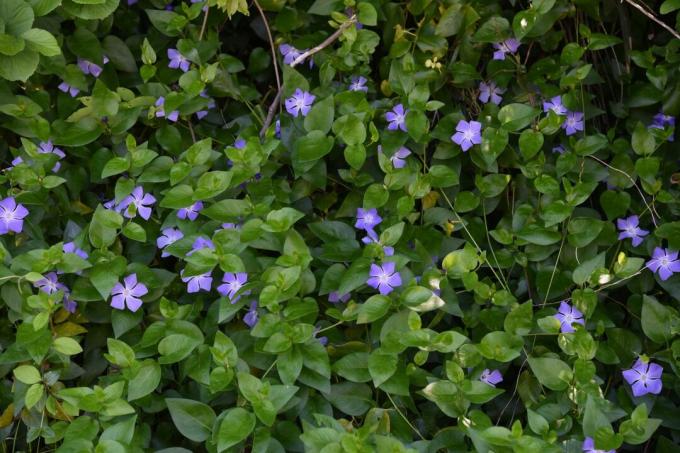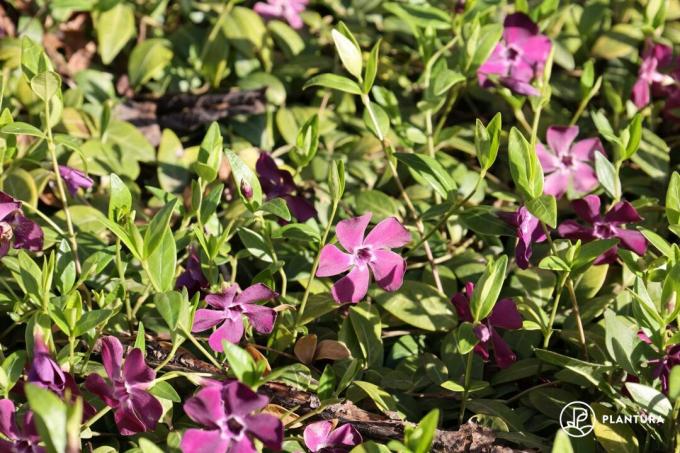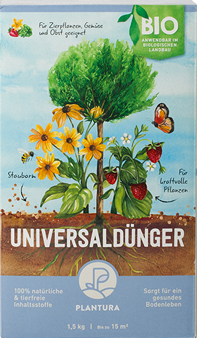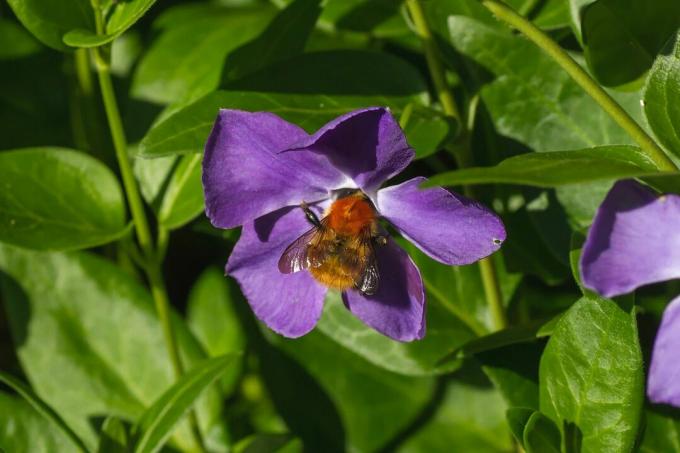The two types of plants, large and small periwinkle, are popular ground covers for various locations in the garden.

Evergreens are a beautiful, undemanding addition to wild herbs and spring bloomers, especially at the edge of trees. The two well-known periwinkle species, large and small periwinkle, differ slightly in certain characteristics and make similar demands on planting and care. The numerous varieties of periwinkle bring variety in the color of the flowers, regardless of whether they are large or small. We show here how to care for the small and the large periwinkle in the garden.
contents
-
Periwinkle: origin and properties
- Large periwinkle
- Small periwinkle
-
Types and varieties of periwinkle
- Varieties of Vinca minor
- Varieties of Vinca major
- Plant evergreens: location, time & procedure
- Care of Vinca minor and Vinca major
- wintering
- How to propagate periwinkle
- Is periwinkle poisonous?
Periwinkle: origin and properties
The two subshrubs Large periwinkle (Vinca major) and lesser periwinkle (Vinca minor) come from southern Europe, both of which now also occur as neophytes in Asia. The two plants are rarely found in nature, even in Germany, where they occasionally grow in forests. The small periwinkle is found much more frequently than the large periwinkle. Both species belong to the genus Evergreen (Vinca) within the dogbane family (Apocynaceae).
As the name suggests, the plants are evergreen, which means they keep their leaves through the winter. Both species have a creeping habit, are perennial and constantly form new roots on the woody shoots. The violet, fivefold flowers appear between March and June and are often visited by insects such as bumblebees and bees. The plants have an abundant supply of nectar, albeit little pollen, and are frequented by wasps and butterflies. In addition, ants are frequent visitors involved in the seed dispersal of periwinkle species. Small and large periwinkles contain a milky sap and are among the poisonous plants.

Large periwinkle
The large periwinkle forms up to 1 m long shoots that crawl over the ground and are equipped with leathery, dark green leaves. True to its name, the large periwinkle develops flowers with a diameter of up to 5 cm and reaches a height of 30 cm. In the fall, the periwinkle may sporadically have a second bloom.
Small periwinkle
With shoots that are up to 2 m long, the small periwinkle grows even more sprawling than the large one. The leathery leaves are yellow underneath and shiny green on top. The growth height of about 15 cm and the smaller flowers with a diameter of 2 to 3 cm justify the name of the small periwinkle. It is also sometimes referred to as small-leaved periwinkle.

Types and varieties of periwinkle
Many varieties are known of both the large and the small periwinkle, which differ, for example, in the color of the flowers. However, the diversity of the small periwinkle is even greater than that of the closely related large periwinkle.
Varieties of Vinca minor
- Vinca minor ‘Atropurpurea’: Purple flowers, but only moderately hardy

- Vinca minor 'anna': With many flowers in blue, very ground covering
- Vinca minor 'Gertrude Jekyll': Very hardy and white flowers
- Vinca minor 'Josefine': Compact, hardy variety with light blue flowers
- Vinca minor 'Marie': Evergreen with blue-purple flowers, very hardy
- Vinca minor 'bowl': Also known as Large-flowered Periwinkle due to the large flowers

Varieties of Vinca major
- Vinca major 'Alba': A periwinkle in white
- Vinca major 'Variegata': True leaves with a cream-colored margin

Plant evergreens: location, time & procedure
Both evergreen species have rather low demands on the location. While Vinca minor prefers a location in the sun, thrives Vinca major best in the shade or partial shade. However, both species tolerate almost all light conditions and only form more or fewer flowers. The soil should be humus and nutritious, sandy and loamy garden soils are best. In the garden, the periwinkle fits perfectly under trees, where it can be combined with ferns or grasses, for example. However, since the periwinkle spreads over a large area, once it has established itself it is hardly possible to rake out fallen leaves. To limit its growth, you can place a border around the planting area.
In order to plant the periwinkle, the soil is first loosened up well in spring and unwanted weeds are removed. Because the latter is hardly possible, especially after the establishment of the periwinkle. Planting can also take place later in the year if sufficient watering is provided.

If the garden soil is poor in nutrients, sandy or very clayey, a high-quality substrate such as ours should be used before planting Plantura organic universal soil placed in the planting hole to improve the soil. Our soil is peat-free and has a loose, airy structure, but is excellent at storing water. The substrate should not be too damp and not too dry, but at best moderately fresh. Now place the periwinkle in the planting hole and fill in the gaps with soil before tapping everything down and watering vigorously. Around 5 plants fit in one square meter, which is why a distance of around 40 cm should be maintained when inserting them. When planting Vinca minor the planting distance can be reduced by a few centimetres. The large periwinkle likes to stand in small groups or groups of around 10 plants, the small periwinkle can also stand in colonies of more than 20 plants.

Evergreen as ground cover: Both types of periwinkle are ideal as ground cover, because the long, creeping shoots constantly form new roots at the nodes and spread out like a carpet.
Tip: You can also plant both types of periwinkle in pots, for example to keep them on the balcony or to limit growth. The hanging shoots look decorative in the pot. Regular pruning and winter protection made of fleece or jute are important to keep the periwinkle vital.
Care of Vinca minor and Vinca major
Vinca minor and Vinca major are fairly hardy garden plants that do not require a lot of care. If it is dry for a long time in summer and in a sunny location, you should water the periwinkle. Fertilization is usually not necessary on nutrient-rich soils, at least in the first few years. Poorer soils, on the other hand, should be treated in spring with a slow-release fertilizer such as ours Plantura organic universal fertilizer be supplied, so that the periwinkle is adequately supplied over the growing season. In winter you should not fertilize the periwinkle.

Plantura organic universal fertilizer
effective long-term effect,
good for the soil, harmless for humans, animals and nature
A pruning of the periwinkle is only necessary if the plant spreads too much. In this case, it can be shortened generously. However, leave a few shoots and dormant eyes so that the periwinkle can sprout properly again. The pruning is best done in spring to also eliminate possible frost damage to the leaves. Cutting off the shoots stimulates branching and gives the periwinkle a bushier appearance. Root residues can be removed from the ground with a digging fork.
wintering
The large periwinkle is hardy because it tolerates temperatures down to – 17 °C. However, frost damage to the leaves can occur. The question remains: it is Vinca minor hardy? The Lesser Periwinkle defies even colder temperatures than its larger relative and can even stand outside at -28°C. In regions with very cold winters or in locations where the periwinkle gets strong sun or wind in winter exposed, it should be overwintered with a layer of mulch, because frost drought can be dangerous here will. The plants then transpire water through the incident sunlight, but cannot take up any replenishment from the frozen soil. In harsh locations, it can also happen that the periwinkle sheds its leaves in spring and then forms new leaves or even freezes completely before it sprout again in spring.

How to propagate periwinkle
There are several ways to propagate periwinkle. The easiest way is to obtain offshoots, because periwinkle is constantly forming new roots with which it anchors itself in the ground. The shoots are placed in the desired direction and separated from the mother plant after rooting.
Green or semi-mature cuttings can be obtained year-round simply by cutting a piece of shoot with a few leaf nodes Cut off, remove the lower leaves and put the shoot with the interface in pots with moist potting soil such as ours Plantura Organic Herb & Seed Soil plugged. Our soil is particularly suitable for young plants and seedlings, as the low nutrient content stimulates strong root growth. The location for the evergreen cuttings should be rather shady.
The mother plant can also be divided in spring, although it must be dug up for this purpose.

Is periwinkle poisonous?
Yes, both the small and the large periwinkle are poisonous, which is partly due to the alkaloids they contain. The milky sap that escapes when cutting periwinkle should not come into contact with the skin and mucous membranes. Pets such as dogs or cats can get poisoned by periwinkle and should not consume the plant parts in large quantities.
Another flowering ground cover is this cinquefoil (Potentilla anserina). Although it is not evergreen, it impresses with its bright yellow flowers. In our special article you will learn how to plant and care for the cinquefoil.
...and receive concentrated plant knowledge and inspiration directly in your e-mail inbox every Sunday!

